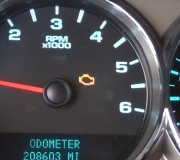Then you have to look at what switches that valve. The closest book I have is a '90 but I think it's the same. That solenoid should have a gray wire and a pink / black wire. The pink / black comes from fuse # 5 in the relay center and has 12 volts whenever the ignition switch is on. The gray wire gets grounded by the Engine Computer when it wants to turn that solenoid on.
Measure the voltage on the gray wire with the ignition switch on. You should find 12 volts. With 12 volts on both wires, the difference is 0 volts so the solenoid is turned off. If you find 0 volts, it is turning on right away which would agree with your running problem and diagnosis. There's two possibilities. The switching circuit in the Engine Computer is shorted or that gray wire is grounded. GM had a lot of computer trouble in the '80s and early '90s but this would not be one of the common problems. It's more likely that wire is grounded and you should rule that out before replacing the computer.
Turn the ignition switch off, unplug the solenoid to prevent reading through it and other circuits, then measure the resistance between that gray wire and ground. The reading should be very high or open. If you find very low resistance or 0 ohms, unplug the connector from the computer that has that wire in it. If the reading is still low, that wire is grounded. Look for where the harness runs over the sharp edge of a metal bracket or is laying against hot engine or exhaust parts. If the short is gone, replace the computer.
I can't tell from this book or experience if your computer has six plugs, six rows of pins in a single plug, or something else. They show groups of wires "A" through "F". The gray wire goes to terminal "A1" which typically means terminal 1 in connector A. If there are six connectors, only plugs "A" and "B" have 12 wires each. All the others have 16 wires.
If you read open or very high resistance to ground on that gray wire when the ignition switch is off, you'll know the wire is not grounded and the problem is in the computer. Even that switching circuit may not be shorted. The problem could be with the computer circuitry that turns on that switching circuit. There's no way to test that. All you can do is observe the results of the tests and use the process of elimination.
This resistance test doesn't always work because the circuit shouldn't be powered up when using an ohm meter, but you can try it. Leave the solenoid unplugged and leave the ohm meter connected to the gray wire and ground. Assuming you're not reading a short, turn on the ignition switch and see what happens to the reading. If it goes real low, that proves the switching circuit is working but it is being commanded on inappropriately by the computer. If that is the case, I can't see any other inputs that would tell the computer to do that so the computer itself is suspect.
A better test is to use a test light. It will give a visual indication and put a small load on the circuit. Connect the ground clip to the battery positive post, then probe the gray wire. Turn the ignition switch on. If the test light turns on that proves the computer is switching improperly and must be replaced. If the test light turns on before you turn on the ignition switch, unplug the connector "A" to determine if the wire is grounded or the computer is shorted.
Friday, March 22nd, 2013 AT 11:59 PM


